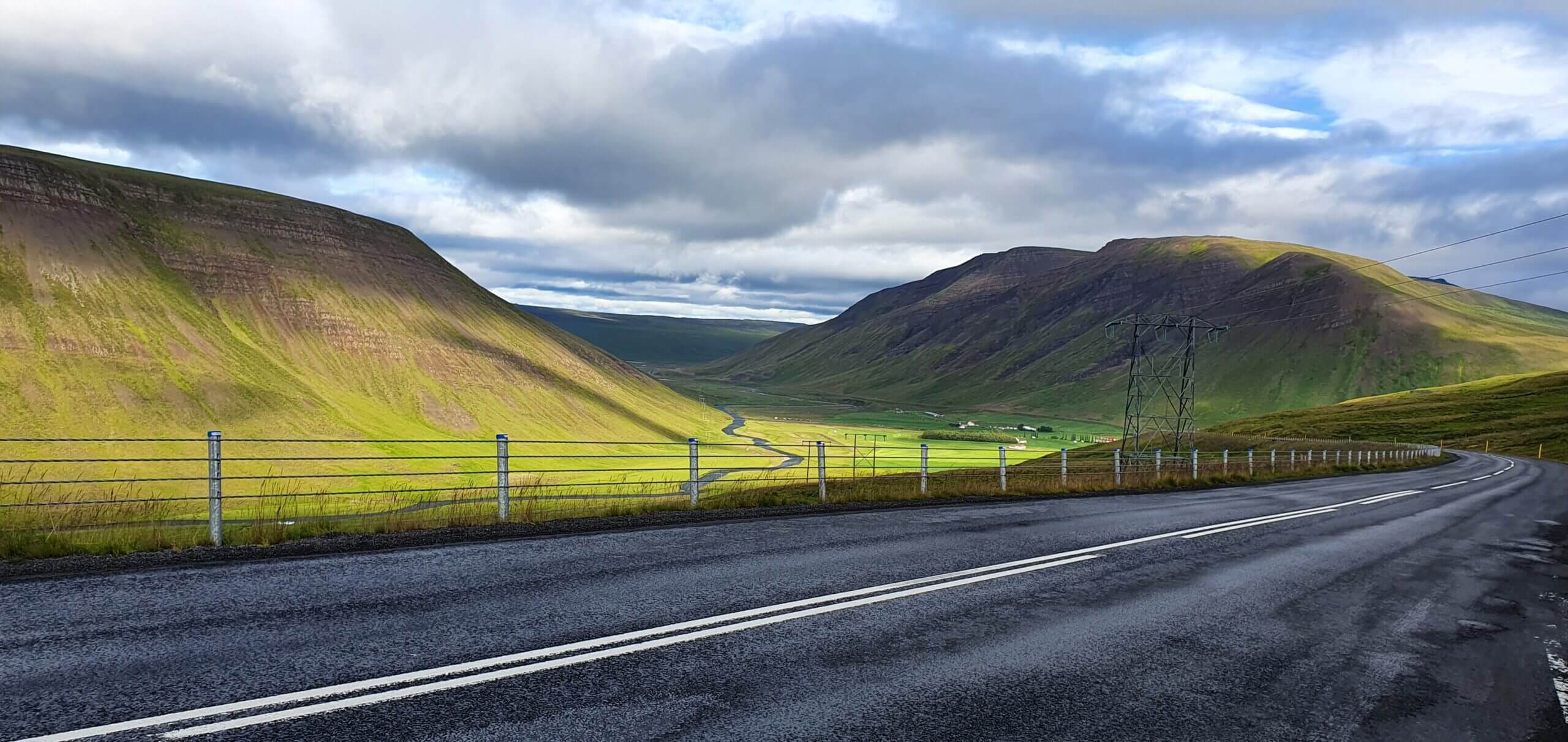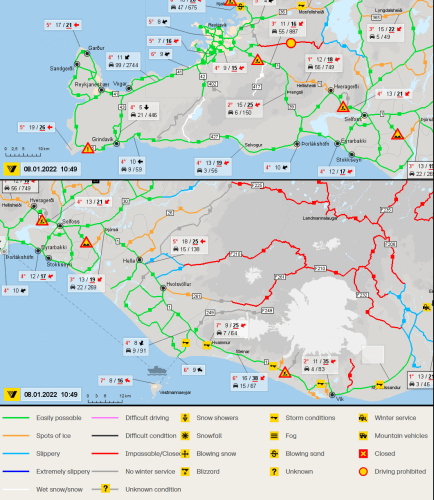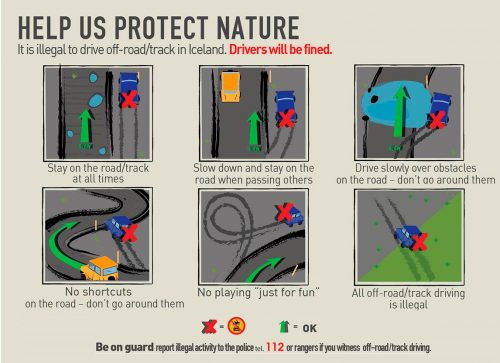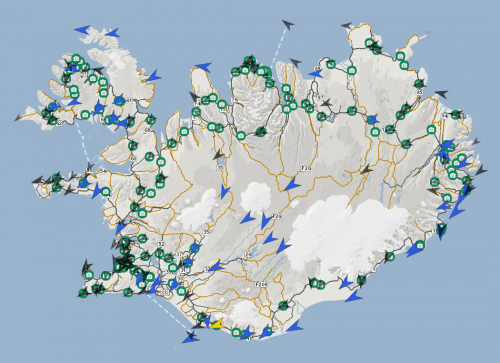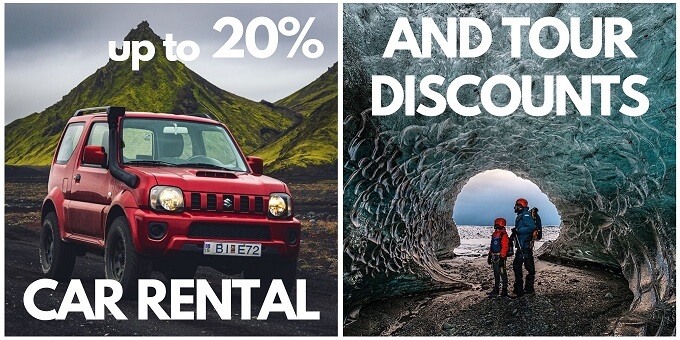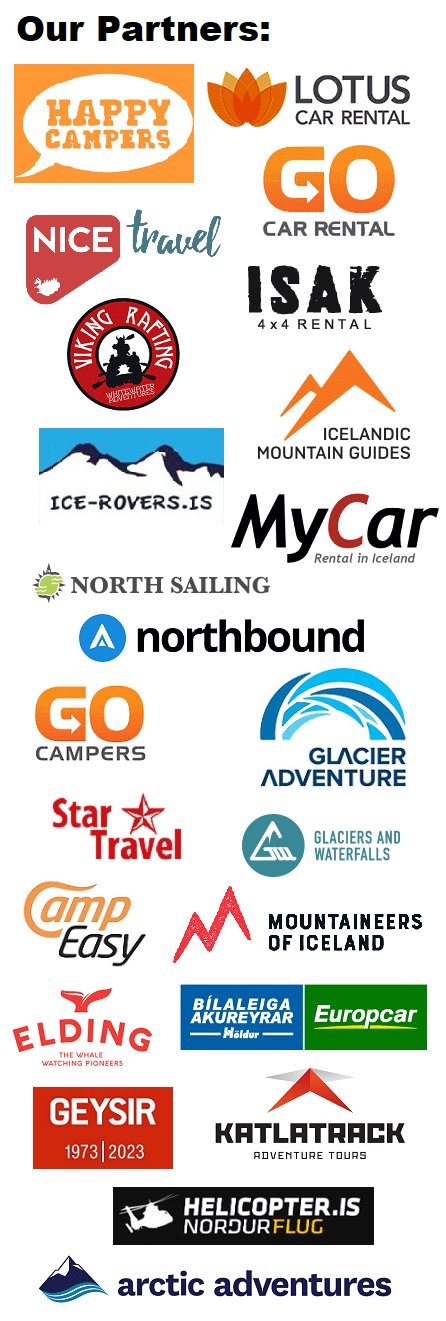The Icelandic road system is pretty simple, yet very interesting. And so are most of the Icelandic roads. Stunningly beautiful, yet sometimes pretty difficult to drive through. The more difficult roads you go for, usually, also the more beautiful the surrounding landscapes are. For difficult roads (F-roads and dirt tracks) you have to prepare thoroughly in advance, though. And to do that, it’s also good to understand the Icelandic road system.
Important read: How to choose the proper car for Iceland.
Contents
Icelandic road system explained
In the most simplified words possible – the more digits the road contains, the more difficult it is 🙂 If the road doesn’t even have a number, then it’s probably even the most difficult and unmaintained one.
The ring road
The ring road – the road no. 1. This is the main and the most famous road which leads around the entire Iceland. In good weather, you may drive it in any car.
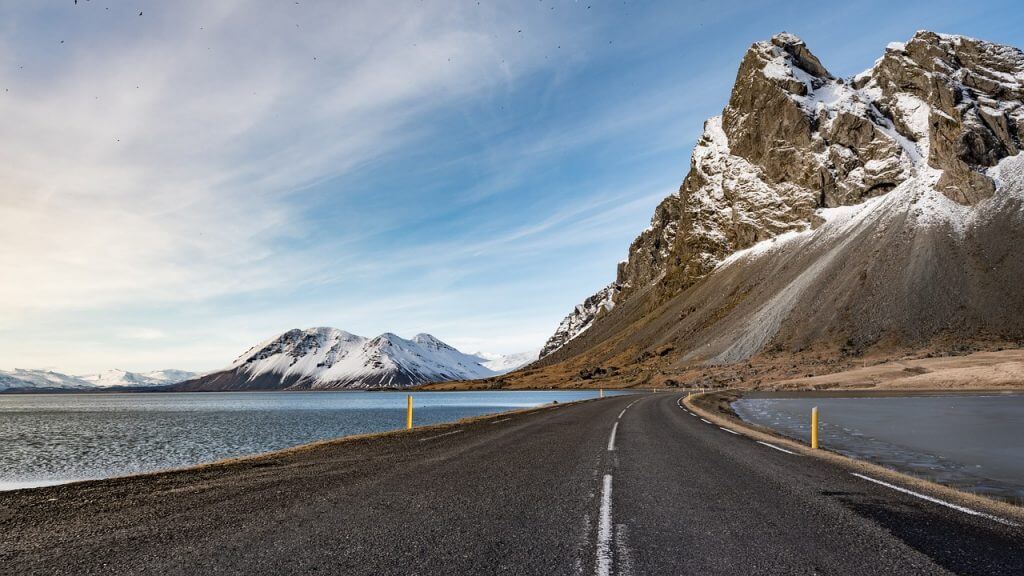
Somewhere on the ring road.
The 2-digit roads
The two-digit roads, e.g. 54. These are the turns/detours from the ring road. Still paved and well-maintained roads. Sometimes may be steeper and narrower (e.g. in Westfjords). In winter, it’s highly recommended to drive a 4×4 car on them.
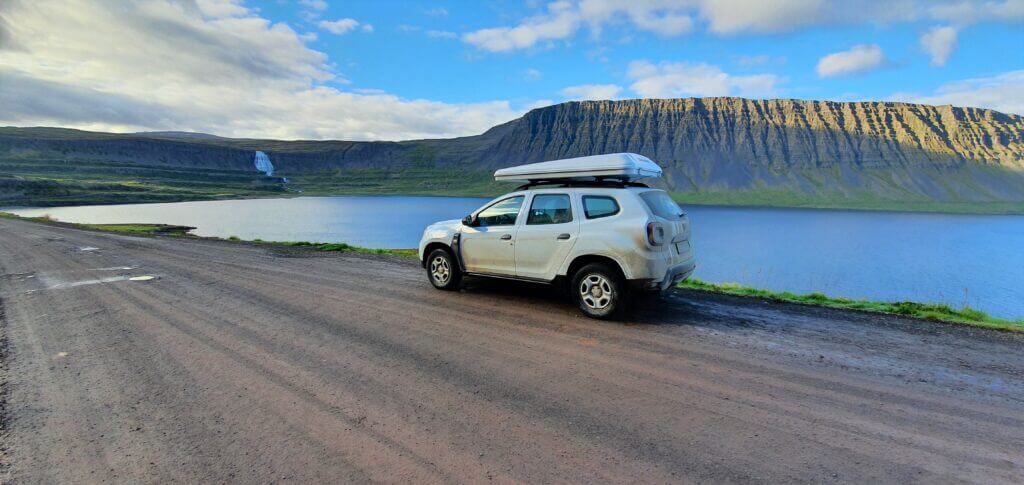
Road 60, or Vestfjarðavegur in Westfjords towards Dynjandi waterfall
The 3-digit roads
The three-digit roads, e.g. 939. These are the roads of worse quality / terrain / maintenance compared to the ring road and the two-digit roads. Usually, these are “dirty” roads, where you drive on the dust, or some kind of gravel, but they are still passable with a 2-wheel drive car in good weather conditions. That can’t be said about worse weather conditions, though – and winter. Always use a 4×4 when driving in worse conditions on three-digit roads.
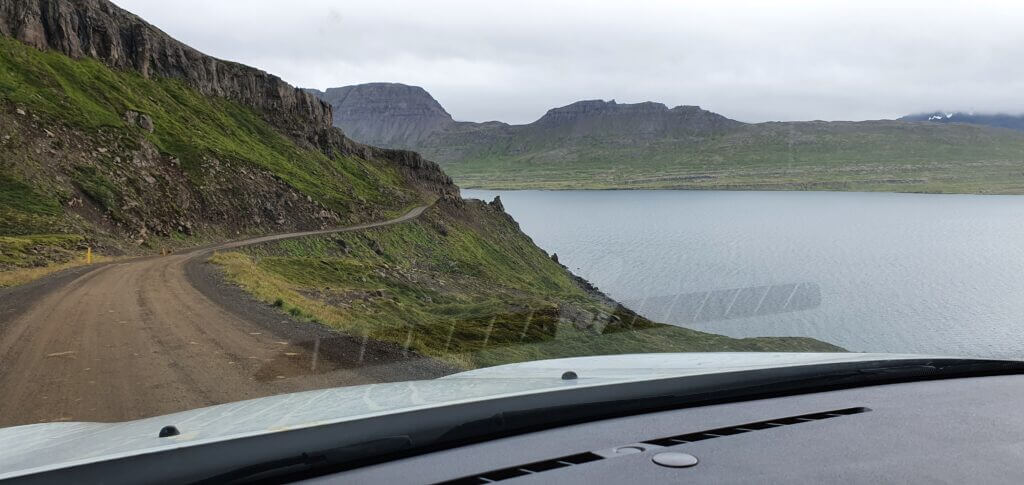
Overview of Strandavegur, a.k.a. road 643
The three-digit roads vary in quality highly. Sometimes they have a lot of potholes and washboards. Sometimes they are narrow and steep. Sometimes they are just straight, good-quality roads that are just not completely paved. The three-digit roads never contain unbridged river crossings, though.
Enjoy car rental discounts and tour discounts in Iceland for our readers.
F-roads
F-roads, e.g. F905. The most famous Icelandic roads are undoubtedly F-roads. Some are afraid about driving on them, some love them. All of you have probably read a lot about F-roads already so I’m not gonna go into general info.
Shortly, F-roads are highland roads that are too remote or too difficult to be paved or regularly maintained. Very often they contain unbridged river crossings of various sizes (though, not always, e.g. F985, F946, F347, …). F-roads may be (and often are) difficult also in many other aspects – steep, narrow, big holes, bad grip, big gravel, sharp stones, uneven ground, etc.
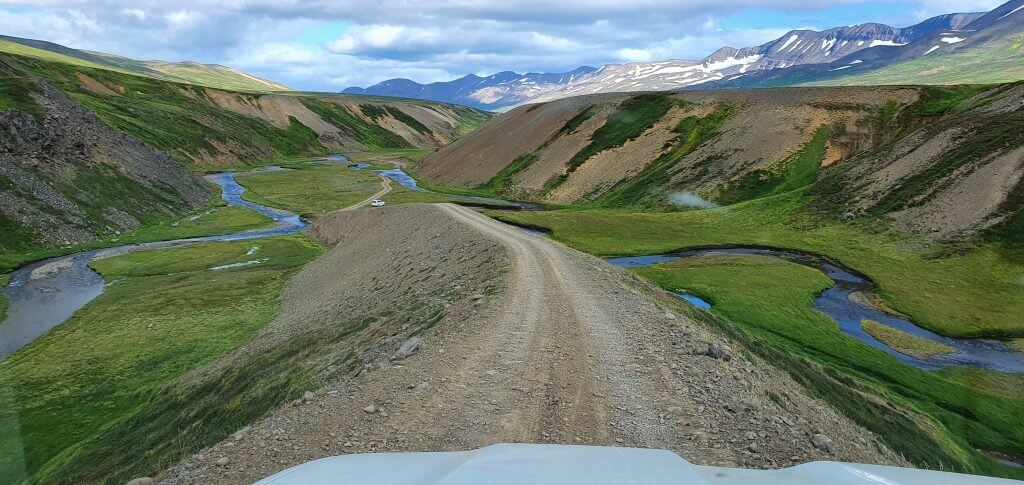
F899 Flateyjardalsvegur
It’s compulsory to drive the F-roads only with 4×4 cars. F-roads are also officially open only in summer (usually July and August). It’s possible to drive the F-roads also outside of summer, however, there is no winter service, which means they are not maintained and most of the time they are virtually impossible to drive on. Outside of the summer, most of the F-roads are passable only by huge super jeeps and experienced drivers. Snow is one of the biggest road dangers in Iceland. See below the section explaining the difference between “impassable”, “closed” and “no winter service” road.
F-roads also often get closed due to bad weather, bad road conditions, too much rain etc. – see the section below – road alerts and weather alerts.
Most of the car rental insurance packages also do not cover many common damages which occur on F-roads (such as damaging the undercarriage/chassis of your vehicle). For example, there is only one company – Lotus car rental – which insures you also for water damage / river crossings. No other company does this!
Luckily, there’s an external insurance provider which can insure you against everything (except river crossings) for an affordable price, which we always use when renting cars in Iceland. RentalCover gives you better coverage for a lower price compared to local insurance packages. If you are interested in more details about how car rental insurance works in Iceland, we wrote an article about how to choose the best car rental insurance in Iceland.
We also wrote a detailed list of all F-roads to help you navigate through beautiful and difficult Icelandic highland roads.
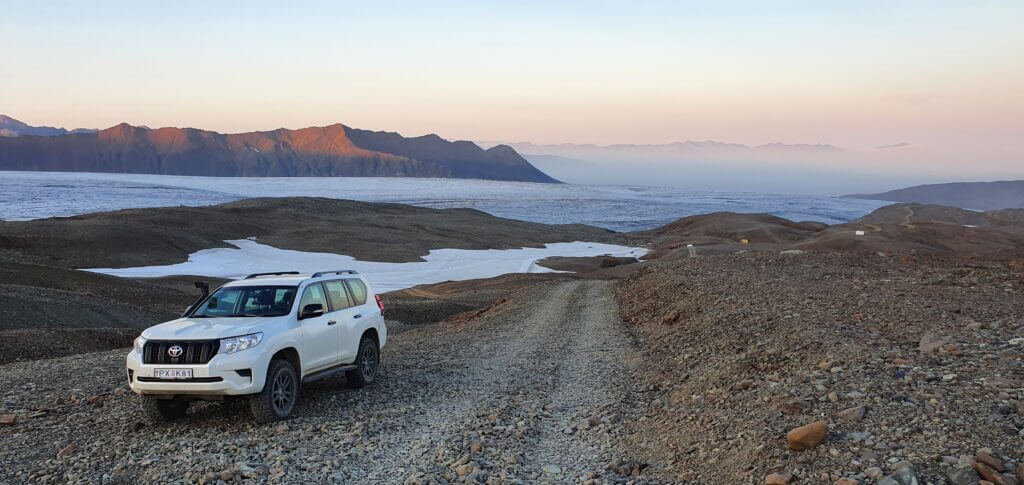
F985 Vatnajokull glacier
Dirt tracks
Dirt tracks, e.g. Krakatindur. “Dirt tracks” is not the official name. It’s a term I use for unpaved non-F-roads which are still considered to be roads and are perfectly legal to drive on (in a proper vehicle and conditions). Most of them, you will not find on Google maps. But you should find all of them on the Icelandic map Iskort.
If the road isn’t marked as a “road” on this map and it doesn’t lead to any settlement/hut then it is forbidden to drive through it and it’s considered off-road driving (see the section below).
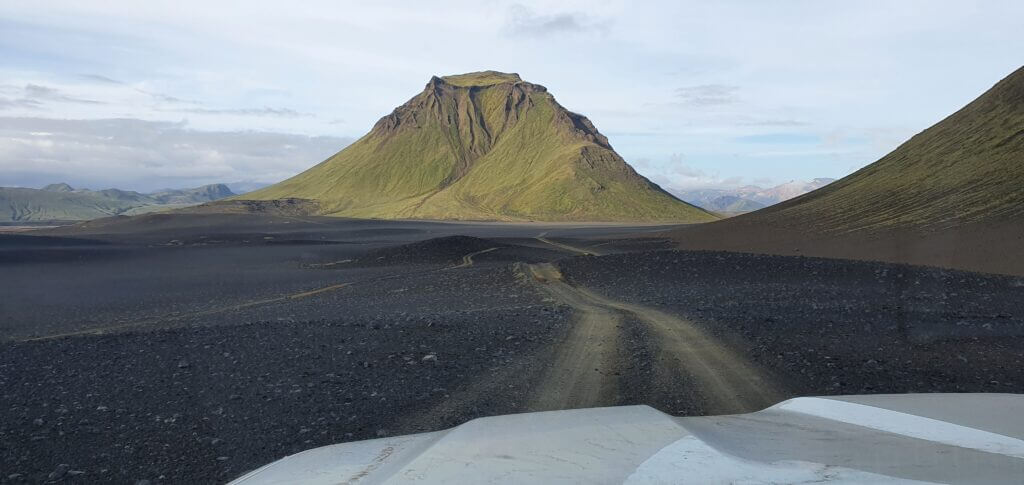
Some well-known dirt tracks in the south include the Krakatindur track (Krakatindsleið), Skaelingar track, Hungurfit track, and several more. The list is pretty long, though. We list some of the dirt tracks in our List of all F-roads. Most of these tracks do have names and if you arrive at their beginning you will find a metal or wooden sign next to it pointing towards a final destination (which is usually a hut or some locally well-known place).
These dirt tracks are the least maintained and often the most difficult Icelandic roads. Some insurance packages are not applicable at all. They are covered by RentalCover insurance packages, though. That’s why we always use RentalCover for insurance when renting cars in Iceland. These tracks are often steep, uneven, full of potholes, may contain big river crossings, there’s often no network coverage and the traffic is very scarce, meaning if anything happens, any help may be far away.
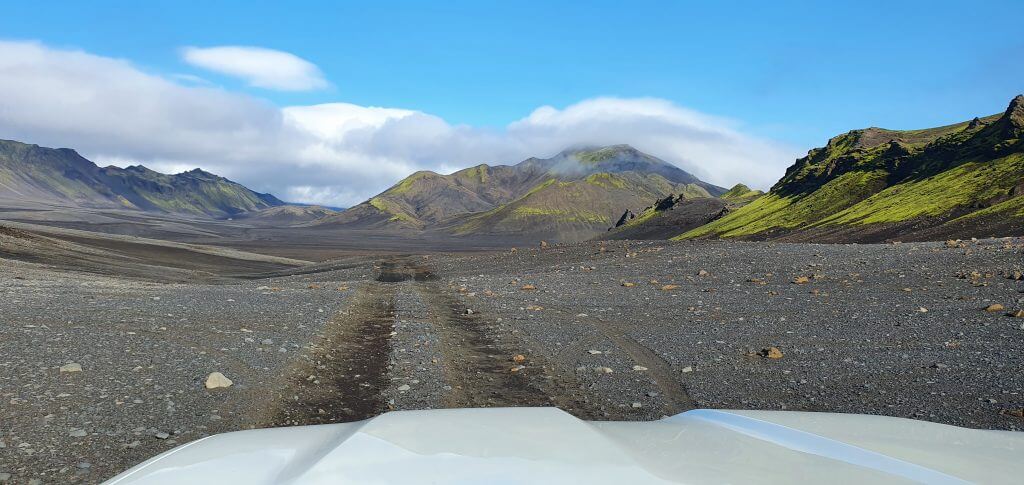
Between Skælingar track and Blautulón track to Langisjór
Moreover, many car rental companies explicitly forbid you to drive on Icelandic tracks. Even with 4×4 cars, it’s often forbidden. F-roads are allowed, but not dirt tracks. Always ask your car rental company and/or read your rental car terms and conditions! If you rent a super jeep, however, these tracks are usually allowed to drive on.
- Please, be very careful and prepare well in advance when driving dirt tracks.
- Never go during weather or road alerts.
- Don’t go outside of summer.
- Have backup plans ready, enough food and water.
- Most importantly, take a proper car – a super jeep.
- Ask someone, ideally a ranger, before going.
- Study the tracks in guides like our List of all F-roads.
- And if you are not willing to put up all these efforts, then definitely DON’T DRIVE them yourself, take a specific guided tour or a private super jeep tour!
Read our guide on how to choose the best insurance for your car rental in Iceland.
Road alerts and weather alerts
The most important thing to look at – and to begin with – are the weather and road alerts. You can find most of these summarized on the website www.safetravel.is. Weather-related alerts are also to be found on en.vedur.is. Road-related warnings are displayed on road.is.
Please always CHECK THESE FIRST. If everything is OK, then proceed with the planning of your trip further. These alerts appear all year round in various forms, so please read them daily.
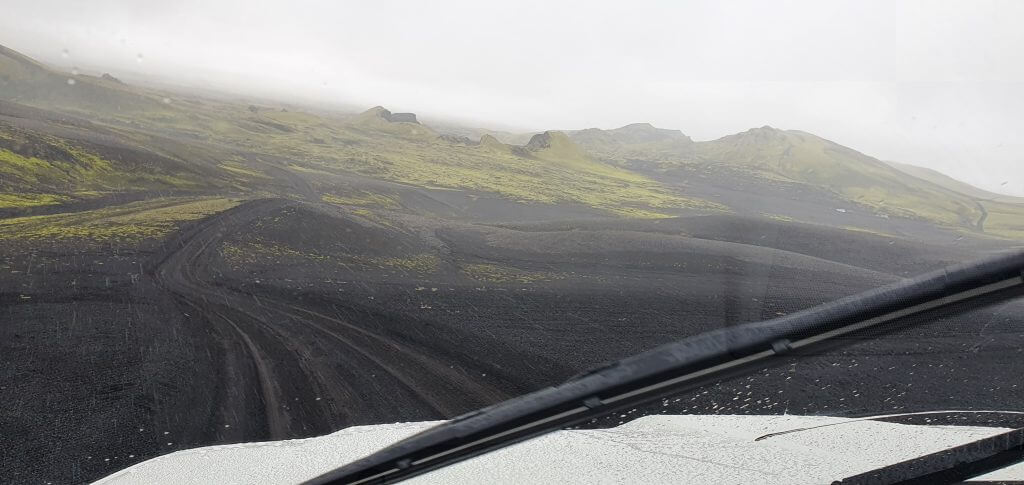
F207 around Laki craters in rainy weather
For example, during our stay in August, it rained a bit more for 3 days and some of the roads became impassable even in the middle of the summer. We planned to cross the country via F26, only to realize the day before the trip that it was marked impassable due to high water level in the Hagakvisl river. We had to change our plans, but better to change your plans than to get your 50 000 Eur worth car rental drown in the river. Or worse – to end up in the river yourself.
The other day there was a strong wind warning for the Snaefelssnes peninsula, hence we decided not to travel there. All of these warnings are useful and can help you save time, nerves, health and money.
Impassable vs. Closed vs. No winter service
This is often mistaken by visitors. Usually, it goes like this:
Tourist: “F249 is impassable.“
Icelander: “Impassable doesn’t mean closed.“
Tourist: “What? But it’s impassable, isn’t it?“
Let’s clear this up:
- Impassable – this means the road is impassable for a typical visitor with a typical 4×4 car, i.e. impassable for virtually all tourists. But not for Icelanders with a super jeep and local experience. It is NOT forbidden to drive this road. BUT, the chances are (99%) you would not be able to drive it without help. An Icelandic guide can take you here, or you can use a special convoy service or a private sit-in guide. Even they can do it only in good conditions. Please don’t drive the impassable road yourself alone, you can die.
- No winter service – this is very similar to “Impassable”, but it’s softer. No winter service means the road is NOT closed. BUT, (if this is the F-road) the chances are (50-90%) you would not be able to drive it without help. There may be 1-meter deep snow, fast-flowing unbridged rivers, or simply anything else because the road just isn’t maintained at all. Again, An Icelandic guide can take you here, or you can use a special convoy service or a private sit-in guide. Please don’t drive the “no winter service” F-road yourself alone, you can get injured. If it’s not an F-road, it’s slightly better but still can be dangerous to drive.
- Closed – this is the only official sign which really makes it illegal to drive the road. No one can drive the closed road under any circumstances.
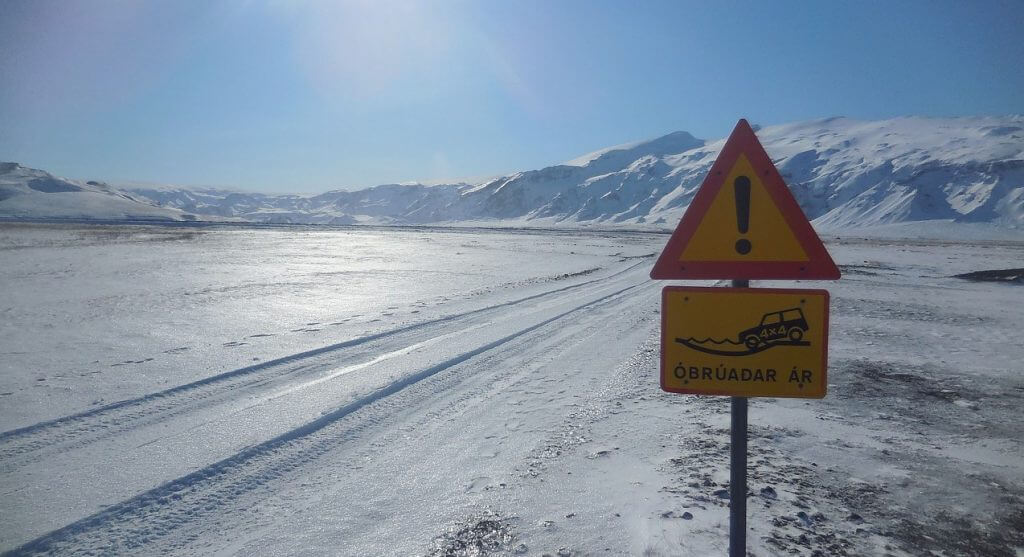
This is how an F-road in great condition looks like when it snows
Off-road driving
Off-road driving is illegal and strictly forbidden in Iceland. This is rule number one. If you drive off the road, you may get a hefty fine of several tens of thousands of Euros/Dollars. The reason is, Icelandic nature is very fragile, and if you e.g. drive through the moss, it may die completely and never grow again. But not everyone understands what off-road driving actually means.
What is off-road driving
- If you drive away from any road – be it normal road, F-road, or any official Icelandic track
- If there’s a puddle/water in the middle of the road and you drive away from the road (e.g. on a moss) to avoid it
- Look at the picture below which depicts it nicely:
What is NOT off-road driving
- Driving through a puddle in the middle of the road
- Driving on the impassable / no winter service road (if you really stick to the actual road, if not, it’s illegal driving!)
- Driving on the dirt track which is not on Google Maps and it’s not even an F-road, but it’s on Icelandic maps
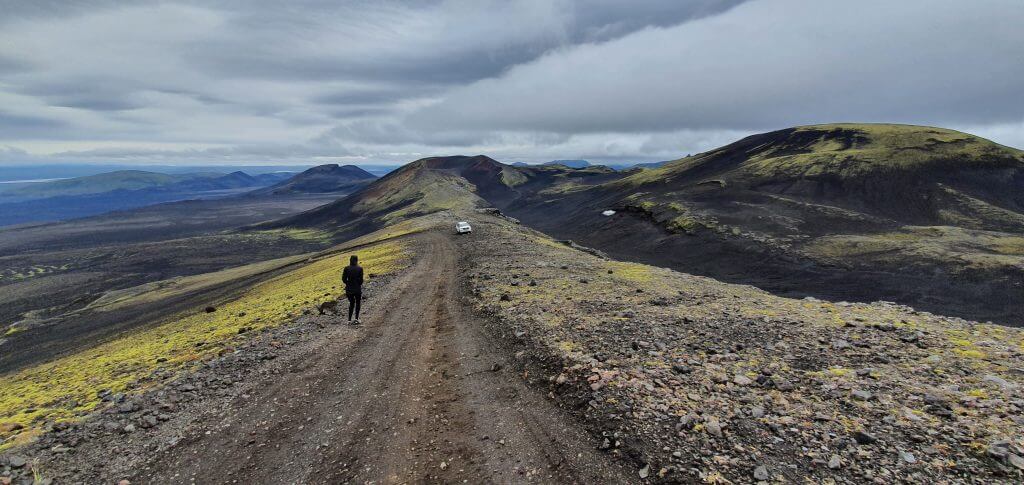
The final ascent of the Hekla track.
The main roads and F-roads are not the only legal roads to drive on in Iceland. There are also “dirt tracks”, usually a road with clear tracks and a sign pointing to their endpoint (e.g. “Hekla”). It’s OK to drive there – BUT – they are usually very difficult (more than F-roads), require a big car and you will drive there entirely on your own responsibility. Check your car rental terms, the chances are it’s forbidden to drive a dirt track unless you rented a super jeep. More on the dirt tracks above.
If there are tracks on the ground, which you cannot find on any maps, nor a local Icelandic map and the tracks don’t lead to any hut / settlement, then this is illegal off-road driving and you are forbidden to do it. Hence, a good rule of thumb is – if you can’t find the road on any map – don’t drive there!
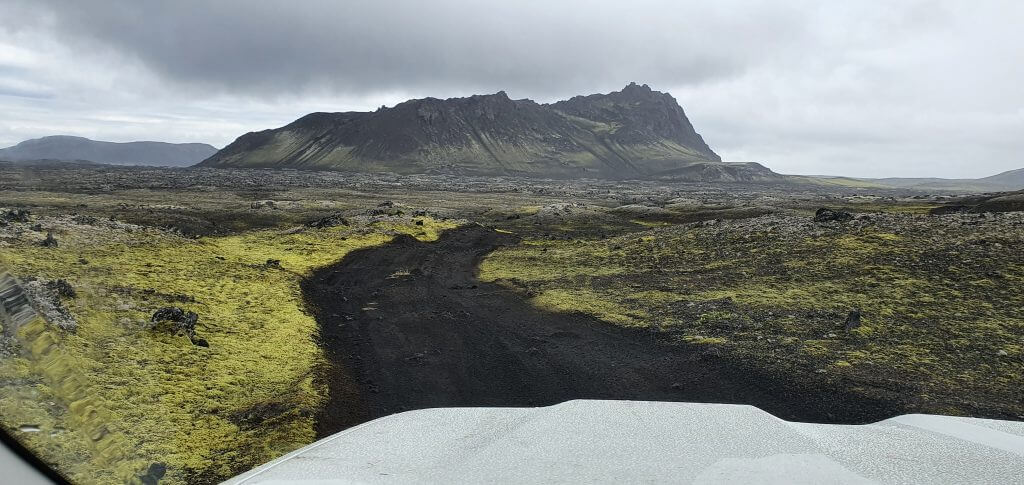
Krakatindur track near Hekla. Watch out for your car’s ground clearance!
Free maps of Icelandic roads
The easiest and most accessible set of maps for Iceland – available also for a free offline download – is Google maps. If you find the road on Google maps, 99% of the time you may drive there (of course except for road alerts and weather alerts which Google doesn’t have). Google maps don’t have all the Icelandic roads though and aren’t entirely precise. That’s why it’s good to combine them with local Icelandic maps:
Vegasja
vegasja.vegagerdin.is/eng/ is a great, updated, official source of all regular Icelandic roads and F-roads. This is a good and precise set of local Icelandic maps. It doesn’t have dirt tracks marked on it, though.
Iskort
vefsja.iskort.is/ is probably the best set of online Icelandic maps I’ve found. They were recommended to me by my friend Haraldur – thank you for that. This map contains also almost all dirt tracks and thus is the most comprehensive Icelandic map source you may possibly find.
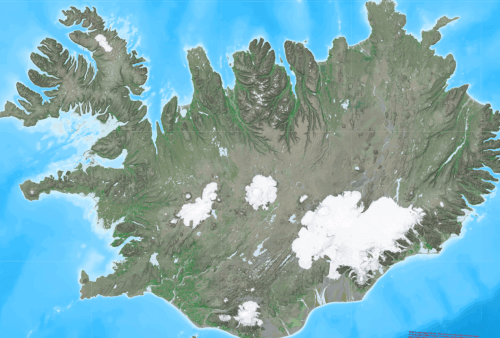
Iskort is the best local Icelandic map with all roads and dirt tracks.
Karta GPS
A great Icelandic road map mobile app is available also for free offline download. Content-wise it’s one of the greatest and you can use it as a navigation! It contains almost all of the roads, including dirt tracks and even a lot of hiking trails! Graphically, it’s maybe not that pleasant compared to the options above, but it serves its purpose well.
Videos of Icelandic roads
We tried to record all of the drives we made in Iceland recently. Subscribe to our Epic Iceland YouTube channel and get the newest videos first.
Our friend Ervin makes wonderful F-road driving videos as well. He has a pretty successful F-road YouTube channel himself, definitely follow him!

